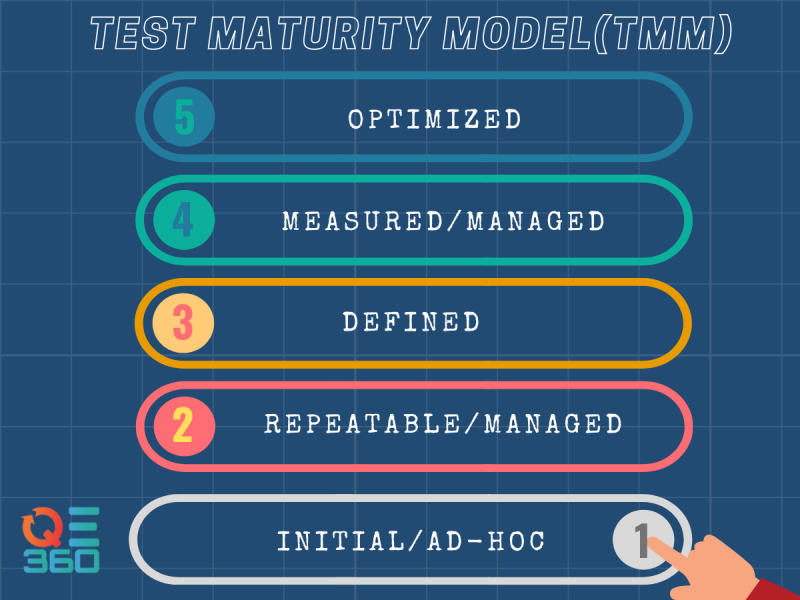
Test Maturity Model
What Is the Test Maturity Model?
The Test Maturity Model (TMM) is a framework that helps organizations assess and improve the maturity of their software testing processes. It defines a set of levels that represent different stages of testing maturity, along with the characteristics associated with each level. By following the TMM, organizations can identify areas for improvement in their testing practices and develop a roadmap for achieving a more mature testing capability.
What Are the Different Levels of the Test Maturity Model?
The five different levels of the Test Maturity Model represent a distinct stage in testing maturity. These levels are
level 1: initial/ad-hoc, level 2: repeatable/managed, level 3: defined, level 4: measured/managed, and level 5: optimized.

- Level 1: Initial/Ad-hoc - This level signifies the most rudimentary stage of testing maturity. Characterized by a lack of formalized processes, testing at this level is often haphazard and undocumented. Testing efforts are sporadic and may not be aligned with development activities. Defect tracking and reporting procedures are typically absent.
- Level 2: Repeatable/Managed - At this level, some basic testing processes begin to emerge. There might be rudimentary test plans or documentation outlining broad testing procedures. However, these documents are likely to be incomplete or inconsistent. Testing activities may be more organized than at Level 1, but they are still largely reactive rather than proactive.
- Level 3: Defined - This level signifies a more formalized approach to testing. Testing processes are documented in greater detail, encompassing aspects like test planning, test case design, and execution. There's a greater emphasis on planning and control, with testing activities becoming more closely aligned with the development lifecycle. Traceability between requirements and test cases may be established at this level.
- Level 4: Measured/Managed - Organizations at this level have well-defined, documented, and integrated testing processes. Testing activities are seamlessly woven into the overall Software Development Lifecycle (SDLC). A focus on measurement becomes prominent, with metrics being employed to assess the effectiveness of testing efforts. Continuous improvement becomes a core principle, with data and feedback being actively utilized to refine testing processes.
- Level 5: Optimized -This level represents the pinnacle of testing maturity. Testing processes are continuously optimized based on data-driven insights and best practices. Innovation is a hallmark of this level, with organizations actively exploring and implementing the latest testing tools and techniques. Defect prevention strategies are prioritized to minimize the introduction of issues throughout the development lifecycle.
It's important to note that the specific names and characteristics of these levels may vary slightly depending on the specific TMM implementation. However, the core concepts remain consistent across different TMM frameworks. By understanding and progressing through these levels, organizations can establish a robust and efficient testing practice, ultimately leading to higher quality software products.
How to Implement the Test Maturity Model?
To implement the Test Maturity Model, an organization needs to follow a well-defined process of leveraging the TMM’s framework to achieve significant improvements in testing efficiency, effectiveness, and overall software quality. The key steps involved in implementing the TMM are assessing the current maturity level, defining the target maturity level, developing a roadmap and action plan, and implementing and monitoring progress, and continuous improvement.
- Assessing Current Maturity Level:The initial step involves conducting a comprehensive assessment of the organization's current testing maturity level. This assessment serves as a critical baseline measurement, enabling organizations to identify their strengths and weaknesses in testing practices. There are two primary approaches to conducting this assessment:
- Self-Assessment: The organization can utilize a self-assessment questionnaire aligned with the TMM levels. This questionnaire typically
consists of a series of questions that evaluate various aspects of testing practices, such as process definition, documentation, test automation, and defect management. - Formal TMM Assessment Tool: Several organizations offer formal TMM assessment tools. These tools provide a more structured and standardized approach to evaluating testing maturity. They may leverage a team of experienced testers who conduct a thorough analysis of the organization's testing processes.
- Self-Assessment: The organization can utilize a self-assessment questionnaire aligned with the TMM levels. This questionnaire typically
- Defining Target Maturity Level:Based on the findings from the current maturity level assessment, the organization should establish a realistic and attainable target maturity level. This target level should be aligned with the organization's overall business objectives and development lifecycle. Factors to consider when defining the target level include:
- Project complexity: More intricate projects may necessitate a higher target maturity level to ensure adequate testing coverage.
- Risk tolerance: Organizations with a lower tolerance for risk may benefit from striving for a more advanced maturity level.
- Resource availability: The target level should be achievable within the constraints of available resources, including personnel, budget, and time.
- Developing a Roadmap and Action Plan:Having established a target maturity level, the organization must create a comprehensive roadmap outlining the steps necessary to achieve it. This roadmap should be detailed and action-oriented, encompassing specific initiatives, milestones, and timelines. Here are some key elements to consider when developing the roadmap:
- Process Improvement Initiatives: Identify specific areas where testing processes need to be improved to reach the target level. This may involve developing or refining test plans, test case design techniques, or defect management procedures.
- Implementation of Testing Tools and Techniques: Evaluate the need for implementing new testing tools or techniques to enhance testing efficiency and effectiveness. This
could involve automation tools, performance testing tools, or exploratory testing methodologies. - Training and Skill Development: Assess any required training and skill development initiatives for the testing team. This could involve training on new
testing tools, methodologies, or best practices.
- Implementing and Monitoring ProgressFollowing the development of the roadmap, organizations need to begin implementing the outlined actions. Effective communication and collaboration between stakeholders, including testers, developers, and project managers, is crucial during this phase. Regular monitoring and progress tracking are essential to ensure the roadmap is on track and adjustments can be made as needed. Here are some key aspects of monitoring progress:
- Tracking Completion of Action Items: Monitor the completion of specific initiatives outlined in the roadmap, ensuring they are implemented within the designated timeframe.
- Evaluation of Testing Metrics: Track relevant testing metrics such as test case coverage, defect detection rates, and time to resolution of defects. This data can be used to assess the effectiveness of implemented changes.
- Regular Reviews and Adjustments: Conduct periodic reviews of the roadmap and testing practices to identify any areas where adjustments are necessary.
- Continuous Improvement:The TMM is not a static model; it is designed to foster ongoing improvement. By utilizing the data collected during the monitoring phase, organizations can continuously refine their testing processes. This continuous improvement culture ensures that the organization maintains a high level of testing maturity and adapts to evolving technologies and project requirements.
By following these steps and embracing a culture of continuous improvement, organizations can leverage the TMM to establish robust and efficient testing practices, ultimately leading to the delivery of high-quality software products.
What Are the Benefits of the Test Maturity Model?
There is a wide range of benefits of the Test Maturity MOdel for organizations seeking to enhance their software development processes. By implementing a structured framework for evaluating and refining testing practices, the TMM can lead to significant improvements in several key areas such as enhanced software quality, improved testing efficiency and productivity, reduced risks, improved communications and collaboration, compliance with industry standards, and continuous improvements.
- Enhanced Software Quality: A cornerstone benefit of the TMM is its positive impact on software quality. By establishing a defined and measurable testing process, the TMM helps organizations identify and rectify defects earlier in the development lifecycle. This proactive approach minimizes the likelihood of bugs persisting into later stages, ultimately resulting in a more robust and reliable software product.
- Improved Testing Efficiency and Productivity: The TMM fosters a more streamlined and efficient testing environment. Through standardized processes and documentation, the TMM reduces redundancy and wasted effort. Additionally, the TMM can guide the selection and implementation of appropriate testing tools and techniques, further optimizing testing workflows and maximizing tester productivity.
- Reduced Risks: A well-defined testing strategy is instrumental in mitigating risks associated with software development. The TMM's structured approach helps organizations proactively identify potential issues and vulnerabilities before they translate into real-world problems. This proactive risk management translates into lower development costs and a more predictable software development lifecycle.
- Improved Communication and Collaboration: The TMM promotes better communication and collaboration between testers, developers, and other stakeholders involved in the software development process. The standardized processes and documentation fostered by the TMM ensure that everyone involved has a clear understanding of testing goals, procedures, and expectations. This enhanced communication fosters a more collaborative environment, leading to more effective problem-solving and improved overall project outcomes.
- Compliance with Industry Standards: Many industries have established testing standards and regulations that software development organizations must adhere to. The TMM can play a vital role in ensuring compliance with these standards. By providing a structured framework for assessing and improving testing practices, the TMM helps organizations demonstrate that their testing processes meet the required benchmarks.
- Continuous Improvement: The TMM is not a static model; it is designed to be a catalyst for ongoing improvement. By providing a clear roadmap for identifying areas for improvement and implementing corrective measures, the TMM empowers organizations to continually refine their testing practices and achieve ever-higher levels of testing maturity.
The Test Maturity Model offers a comprehensive and practical approach for organizations to elevate their software development processes. By leveraging the TMM's structured framework and its associated benefits, organizations can achieve significant improvements in software quality, testing efficiency, risk management, communication, compliance, and overall project success.
